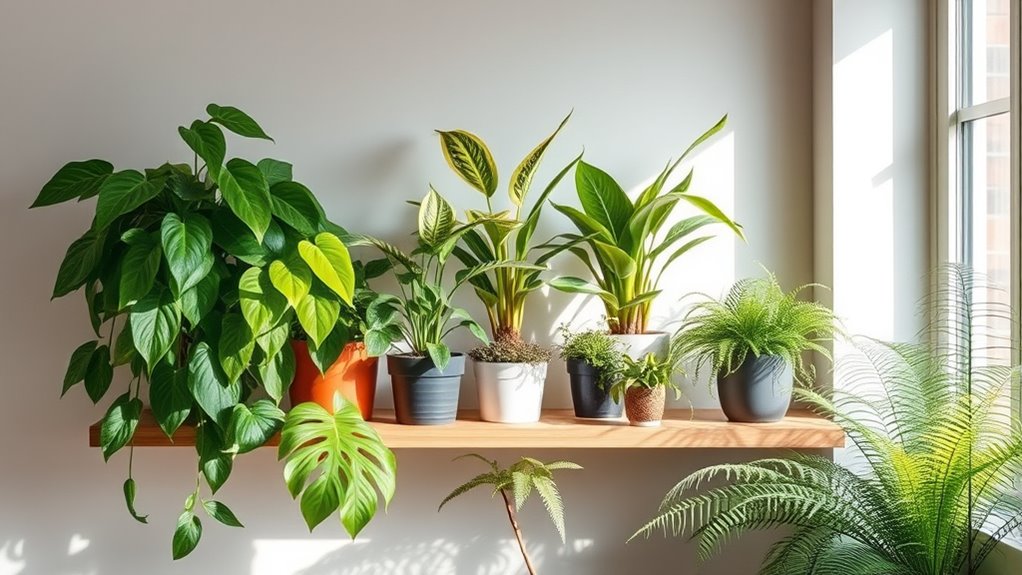If you’re new to indoor gardening, start with easy-care plants like snake plant, pothos, and peace lily—they thrive even in low light and need minimal watering. Other great options include ZZ plant, spider plant, rubber plant, philodendron, cast iron plant, and Chinese evergreen, all known for their resilience and air-purifying qualities. Want to discover more about making your space greener? Keep exploring to find out which plants suit your lifestyle best.
Key Takeaways
- Choose low-maintenance plants like Snake Plant, ZZ Plant, and Pothos that thrive with minimal watering and care.
- Opt for pet-safe options such as Spider Plant, Cast Iron Plant, and Chinese Evergreen to ensure safety for children and pets.
- Select plants adaptable to low light conditions like Peace Lily, Snake Plant, and Cast Iron Plant for versatile placement.
- Prioritize air-purifying varieties such as Snake Plant, Peace Lily, and Spider Plant to improve indoor air quality easily.
- Focus on plants with forgiving care needs, like Aloe Vera and Rubber Plant, ideal for beginners with busy schedules or limited gardening experience.
Snake Plant (Sansevieria)
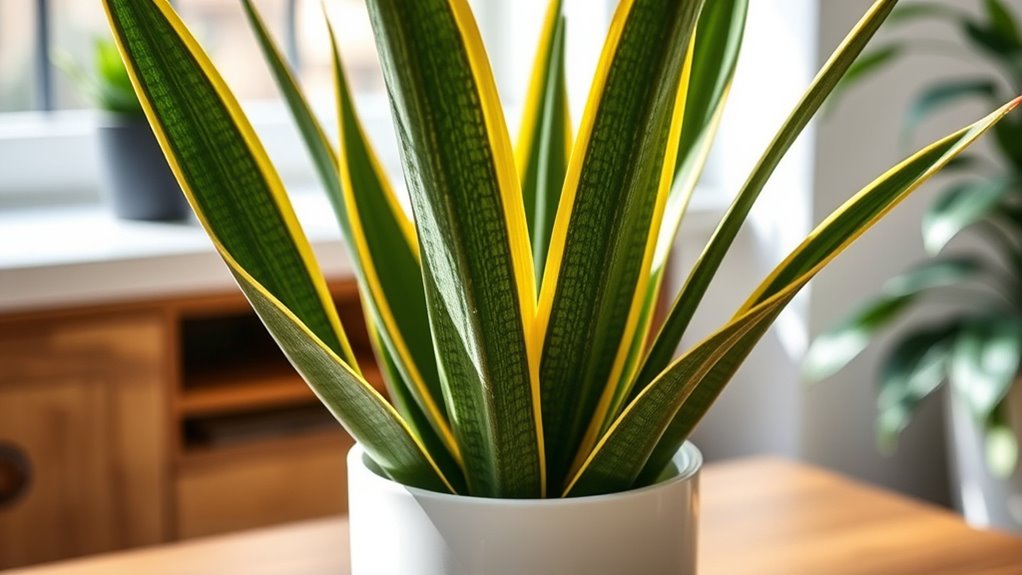
Have you considered the Snake Plant (Sansevieria) for your indoor space? This popular plant features tall, upright, sword-like leaves that can grow over 3 feet.
One of its biggest perks is its ability to thrive in low light, making it perfect for dim corners or shaded rooms. Its adaptability to various indoor conditions means it’s a versatile choice for many households.
Its ability to thrive in low light makes it ideal for dim corners and shaded rooms.
The snake plant is incredibly low maintenance—you only need to water it every two to three weeks, allowing the soil to dry out completely between waterings.
It prefers well-drained soil and resists pests and neglect, so even beginners can keep it healthy with minimal effort.
Plus, it’s an excellent air purifier, removing toxins like benzene, formaldehyde, and xylene from your indoor air. Its air-purifying qualities are backed by research, making it a healthy addition to your living space.
As part of its easy-care qualities, the snake plant is a stylish and resilient choice for any beginner indoor gardener.
Pothos (Epipremnum Aureum)
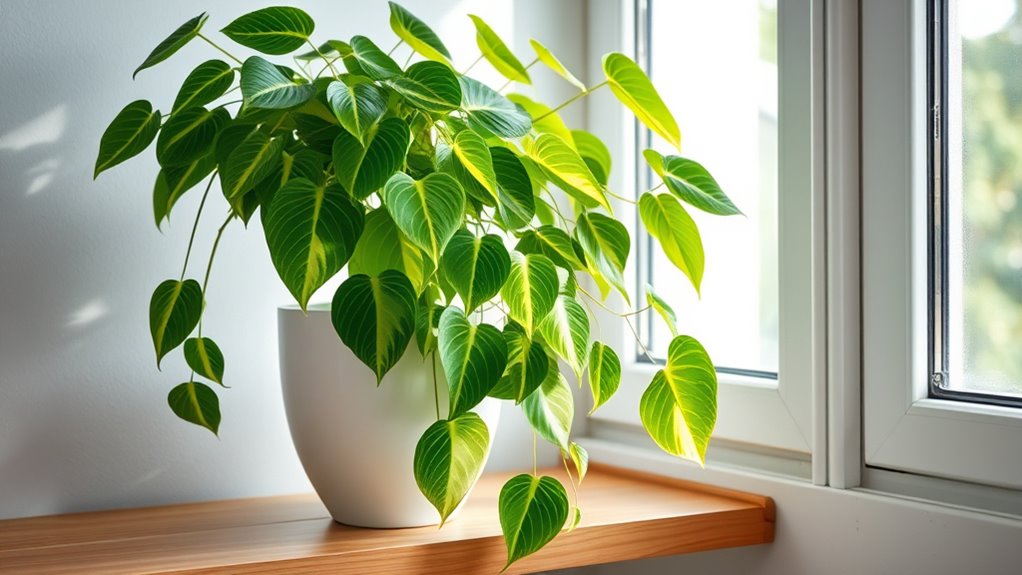
Looking to add some lush greenery to your indoor space? Pothos (Epipremnum aureum) is perfect for beginners because it thrives indoors with minimal effort. It tolerates low to bright indirect light, making it versatile for various locations.
You don’t need to worry about frequent watering—just let the soil dry out completely between waterings, and it’ll stay healthy. Pothos is low maintenance and grows quickly, so you’ll see results fast. Its trailing habit allows you to display it in hanging baskets, on shelves, or let it climb. Keep in mind, though, it’s toxic to pets and humans if ingested, so place it out of reach. Proper environmental considerations help keep your indoor space safe and healthy for everyone. Additionally, understanding industry trends can help you choose the best plants for your specific environment. Being aware of mental wellbeing impacts associated with indoor plants can enhance your overall wellness benefits. Recognizing plant care tips can further ensure your pothos remains vibrant and healthy over time. Regularly observing plant growth patterns can also help you troubleshoot any issues early on.
Peace Lily (Spathiphyllum)
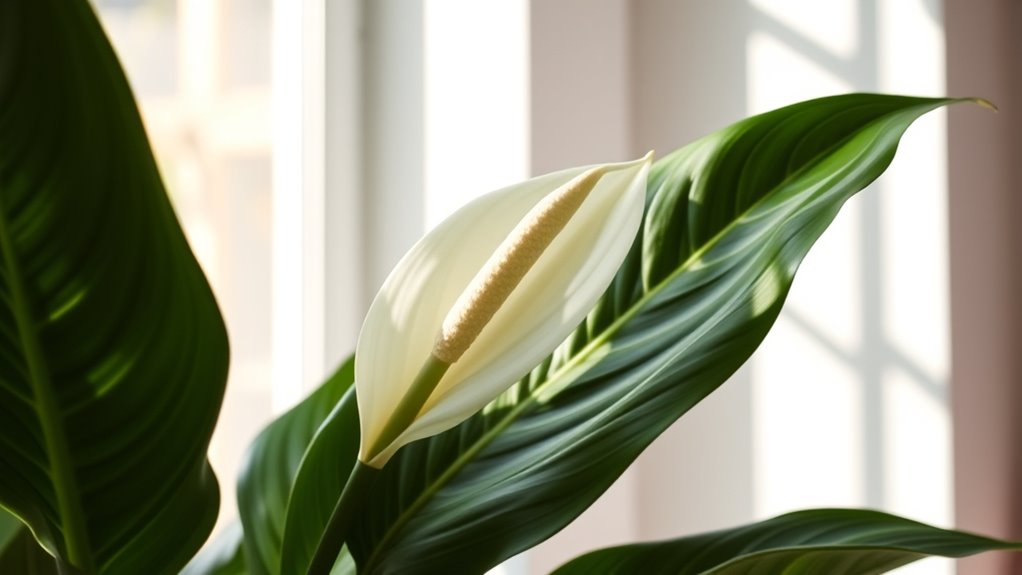
A Peace Lily (Spathiphyllum) adds a touch of elegance to your indoor space with its glossy, dark green leaves and striking white flowers that bloom in spring and summer. It thrives in low to medium light conditions, making it perfect for spots with indirect sunlight.
To keep your peace lily happy, guarantee the soil remains moist but well-drained; water when the top inch feels dry. This plant not only looks beautiful but also helps purify indoor air by removing toxins like benzene and formaldehyde.
Keep soil moist but well-drained; water when the top inch feels dry for a healthy, air-purifying Peace Lily.
Be cautious if you have pets, as peace lilies are toxic if ingested. With minimal care, you’ll enjoy its graceful presence and air-cleaning benefits daily.
- Perfect for shaded corners or areas with indirect sunlight
- Needs consistent moisture without waterlogging
- Enhances indoor air quality effortlessly
ZZ Plant (Zamioculcas Zamiifolia)
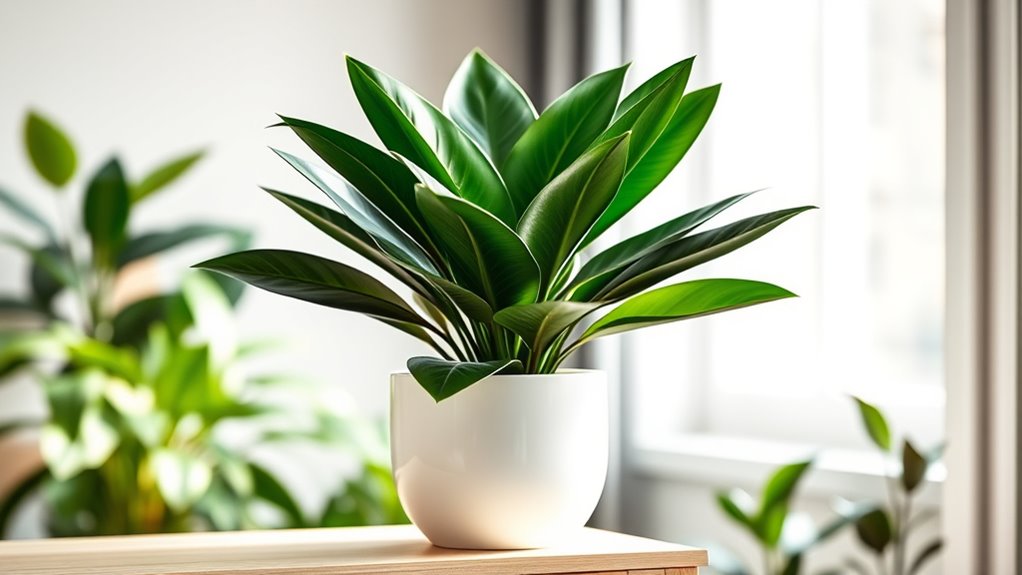
The ZZ Plant is an excellent choice if you have low light spots or a busy schedule. It can survive with infrequent watering and tolerates shaded areas well. Additionally, it benefits from smart marketing strategies when being sold online, helping new plant enthusiasts discover its benefits. Just remember to keep it out of reach of pets, as it’s toxic if ingested. Its low maintenance requirements make it particularly suitable for beginners who want a resilient indoor plant. Moreover, its ability to thrive in low light environments makes it ideal for various indoor settings. As automation advances in business operations, plants like the ZZ Plant can be sourced more efficiently to meet increasing consumer demand. Maintaining proper cookie consent preferences can also ensure a secure online shopping experience for those purchasing plants digitally.
Low Light Tolerance
If your space receives limited natural light, the ZZ Plant (Zamioculcas zamiifolia) is an excellent choice because it thrives in low-light conditions. This makes it one of the top indoor plants for beginners who want a resilient plant that doesn’t need much sunlight.
The ZZ Plant’s glossy, deep green leaves adapt well to shade, keeping their vibrant appearance even in dim rooms. It’s also low-maintenance, surviving for months without water, which simplifies plant care.
To guarantee healthy growth, just remember to water only when the top inch of soil is dry and use well-draining soil.
- Perfect for spaces with minimal natural light
- Requires minimal watering and attention
- Keeps its lush look in shaded spots
Infrequent Watering Needs
Since it stores water in its thick, glossy leaves and rhizomes, the ZZ Plant (Zamioculcas zamiifolia) can go up to four months without needing a drink. This drought-tolerant plant is perfect if you’re looking for a low-maintenance option that doesn’t require frequent watering. You can set a relaxed watering schedule, knowing it thrives with infrequent attention. ZZ Plants prefer soil that dries out completely between waterings to prevent root rot, making overwatering a common mistake. Its ability to withstand irregular watering and neglect makes it ideal for busy beginners or those who forget to water regularly. With this plant, you get a beautiful, hardy indoor companion that minimizes your watering chores while still adding greenery to your space. Additionally, using a self-watering pot can help maintain the proper moisture level and further simplify care. Proper light conditions can also enhance its growth and overall health, making it even easier to care for. Recognizing the plant’s adaptability to various indoor environments can further simplify your care routine.
Spider Plant (Chlorophytum Comosum)

Are you looking for an easy-to-care-for indoor plant that adds a touch of greenery and improves your air quality? The Spider Plant (Chlorophytum Comosum) is perfect for beginners. It’s low maintenance and thrives in various indoor environments. Its long, arching leaves with green and white variegation create a lively display.
Plus, it develops small offshoots called “spiderettes” that you can easily propagate. This plant tolerates low to bright indirect light and only needs watering when the top inch of soil feels dry.
Known for its air purifying qualities, it helps remove toxins like formaldehyde and carbon monoxide from indoor air. If you want a versatile, decorative, and health-friendly indoor plant, the Spider Plant is an excellent choice.
Known for purifying air and removing toxins like formaldehyde and carbon monoxide from indoor spaces.
- Easy to care for and adaptable
- Requires minimal watering
- Boosts indoor air quality
Aloe Vera (Aloe Barbadensis Miller)
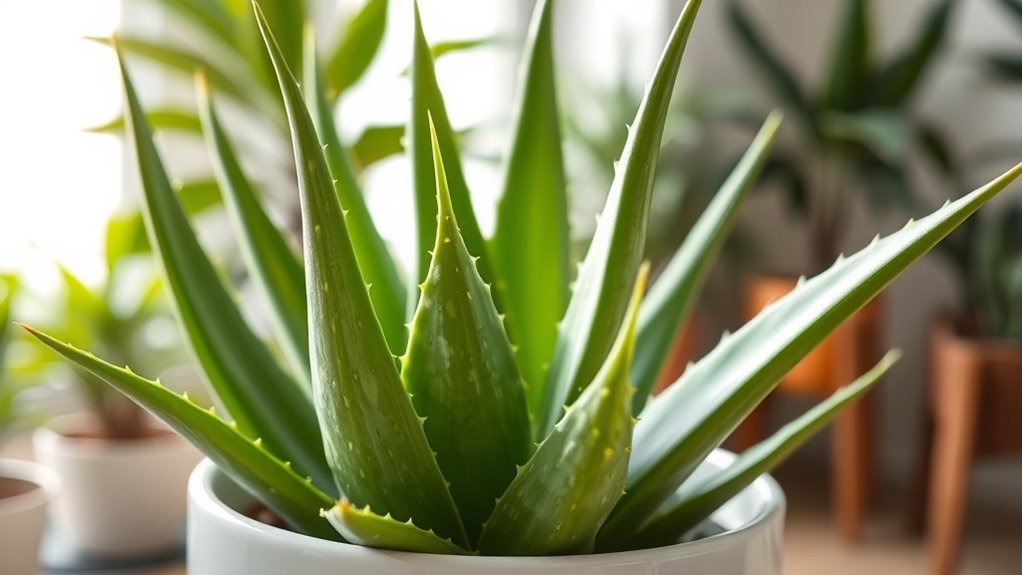
Like the Spider Plant, Aloe Vera (Aloe barbadensis Miller) is a low-maintenance indoor plant that’s perfect for beginners. This resilient succulent thrives in full sun and well-drained soil, making it ideal for indoor spaces. You’ll only need to water it every 2-3 weeks, since overwatering can cause root rot. Let the soil dry out completely between waterings to keep your plant healthy. Aloe Vera’s leaves contain a gel with medicinal properties, often used to soothe burns and skin irritations. It prefers slightly acidic to neutral soil, around pH 6.0, and should be placed in a sunny spot indoors. Its hardy nature and minimal care requirements make Aloe Vera a top choice among indoor plants for those new to gardening. Understanding plant care essentials can help you maintain healthy indoor greenery.
Rubber Plant (Ficus Elastica)
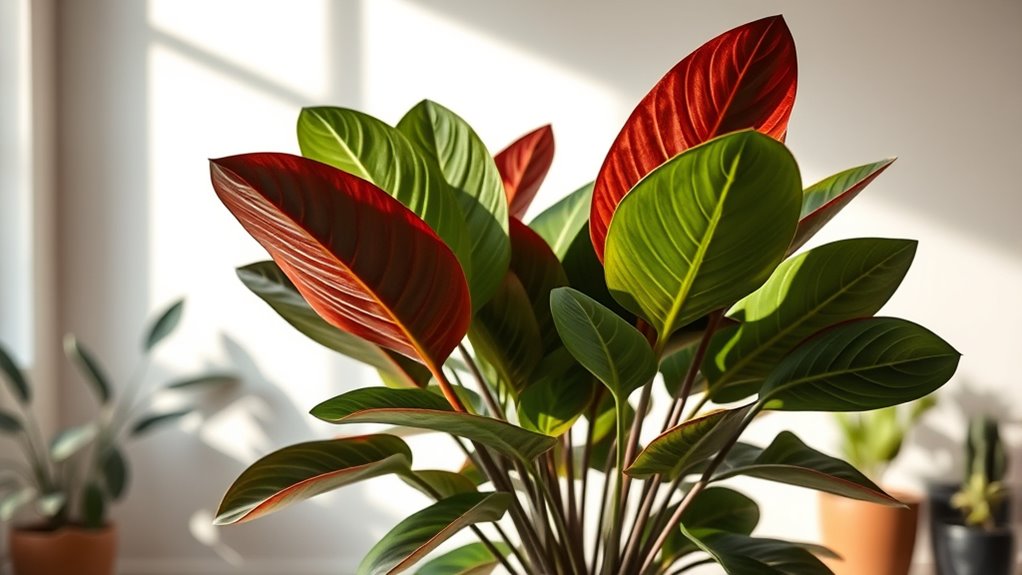
The Rubber Plant adds stylish, lush foliage to your space with its large, glossy leaves. It can handle lower light levels, making it a versatile choice for various indoor areas. Plus, it’s easy to care for, requiring only simple watering and well-draining soil. Being a popular choice among indoor plants for beginners, it is well-suited for those new to plant care.
Stylish Indoor Foliage
Adding a Rubber Plant (Ficus elastica) to your indoor space instantly creates a bold, stylish focal point. Its large, glossy, oval-shaped leaves, reaching up to 12 inches, add a lush, tropical vibe that elevates your decor. This plant’s stylish foliage makes it a standout among indoor plants, providing visual interest and texture. It’s surprisingly low maintenance, thriving with weekly watering and tolerating bright, indirect light, though it can adapt to lower light conditions. Plus, its impressive height—up to 10 feet—adds vertical drama to any room. You’ll love how it combines elegance with easy care. Incorporating natural materials such as wood or linen in your decor can further enhance the authentic, rustic charm that pairs beautifully with indoor greenery.
Low Light Tolerance
A Rubber Plant (Ficus elastica) is a versatile choice for indoor spaces with limited natural light. As an indoor plant, it can tolerate low light conditions, making it perfect for shaded corners or rooms with minimal sunlight. While it prefers bright, indirect light for ideal growth, it can survive in dimmer spots with slower development. Keep in mind, in low light, the plant’s leaves may lose some vibrancy, and growth might slow down. To keep your Rubber Plant healthy, avoid direct sunlight, which can scorch its leaves even in brighter settings. Regularly rotating the plant helps ensure even light exposure. As a beginner, you’ll find this resilient plant suitable for various indoor environments with limited natural light. Additionally, understanding advancements in natural language processing can help in identifying optimal care instructions and troubleshooting tips for indoor plants. Incorporating plant-specific research can further enhance your ability to care for your Rubber Plant effectively. Moreover, paying attention to soil quality and watering routines can significantly impact its overall health and growth. Staying informed about latest AI technologies can also assist in automating and optimizing your plant care routines for better results.
Easy Maintenance Needs
Since the Rubber Plant (Ficus elastica) is known for its resilience, it requires minimal maintenance to thrive indoors. It’s easy to grow and adapts well to various indoor environments, making it ideal for beginners. Its low-maintenance plant needs are straightforward: provide bright, indirect light, and water when the top inch of soil feels dry—usually once a week. Regularly wiping its glossy leaves keeps dust off and supports photosynthesis. To prevent root crowding, repot every 1-2 years in nutrient-rich, well-draining soil. Overall, this plant demands little fuss but offers a lush, vibrant addition to your space. Additionally, understanding its horsepower of electric dirt bikes can be useful if you’re interested in other powered outdoor equipment, as these bikes produce between 10 to 20 horsepower, comparable to traditional gas-powered bikes. Maintaining proper watering techniques ensures your Rubber Plant stays healthy and vigorous with minimal effort.
Philodendron (Philodendron Spp.)
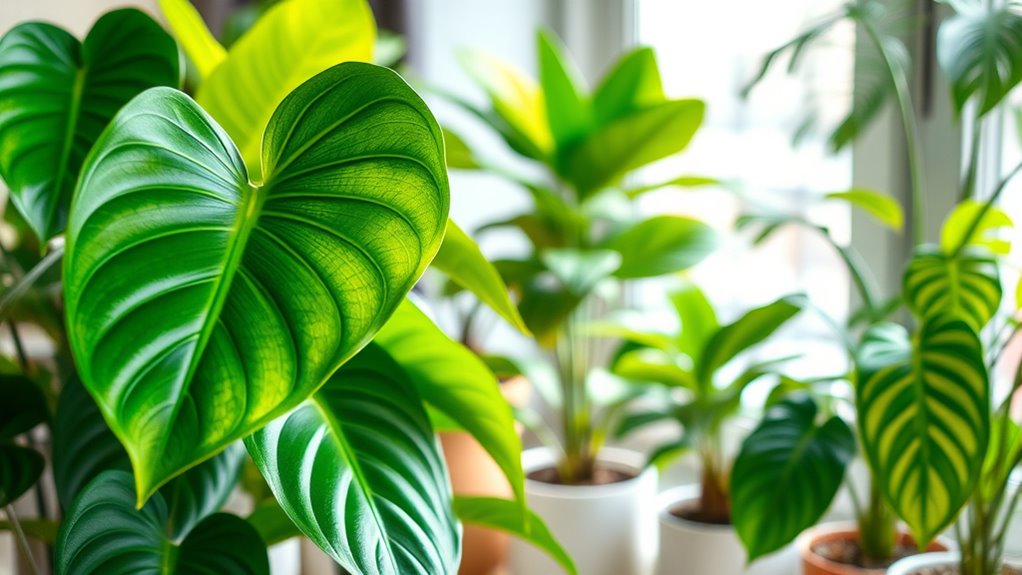
Have you contemplated a Philodendron for your indoor space? This versatile, low-maintenance plant features large, glossy leaves that bring vibrant greenery to any room. It thrives in indirect light, making it perfect for spotty or shaded areas.
You won’t need to water it often—every 1-2 weeks is enough, just verify the topsoil dries out between waterings to avoid root rot.
Many varieties, like the Heartleaf Philodendron or Philodendron Brasil, are great for beginners and easy to propagate through stem cuttings.
The plant prefers warm, humid environments and benefits from occasional fertilizing during growth.
While generally safe for humans, some species contain calcium oxalate crystals, which can cause irritation if ingested by pets or children.
Cast Iron Plant (Aspidistra Elatior)
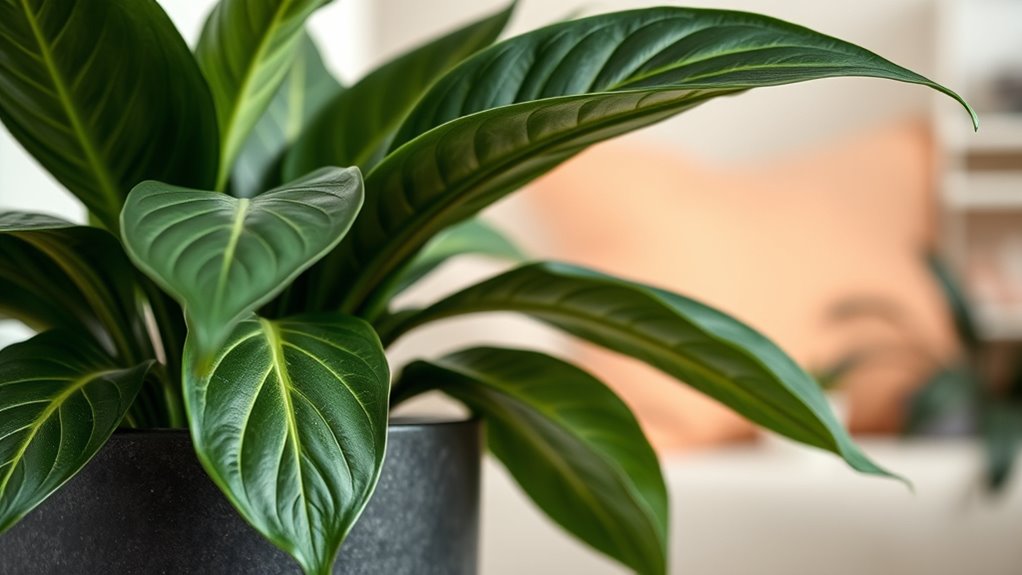
The Cast Iron Plant is incredibly durable and easy to care for, making it perfect for beginners. It can survive low light and infrequent watering without much fuss.
Plus, it’s safe for both kids and pets, so you can enjoy lush greenery without worries.
Durability and Care Needs
If you’re looking for a resilient indoor plant, the Cast Iron Plant (Aspidistra elatior) is an excellent choice. Its durability makes it perfect for busy or forgetful plant owners.
This plant is low-maintenance and neglect-tolerant, thriving even with minimal attention. It can handle low light, temperature fluctuations, and irregular watering without issues.
You won’t need to worry about frequent pruning or special care routines. Its large, glossy leaves add lush greenery to any space, and it can survive weeks without watering.
Toxicity and Safety
Because the Cast Iron Plant (Aspidistra elatior) is non-toxic to both humans and pets, it’s a safe choice for households with children or animals.
Its pet-safe status assures you don’t have to worry about accidental ingestion or skin irritation, making it a reliable option for safety-conscious households.
The plant’s durability and well-documented toxicity profile mean it won’t cause poisoning or adverse reactions.
Despite its toughness, Aspidistra elatior contains no harmful compounds, reinforcing its non-toxic nature.
Always verify specific varieties or hybrids, but generally, this plant is considered safe for all household members.
Choosing a non-toxic, pet safe plant like the Cast Iron Plant adds beauty without compromising safety, giving you peace of mind in your indoor space.
Chinese Evergreen (Aglaonema Commutatum)
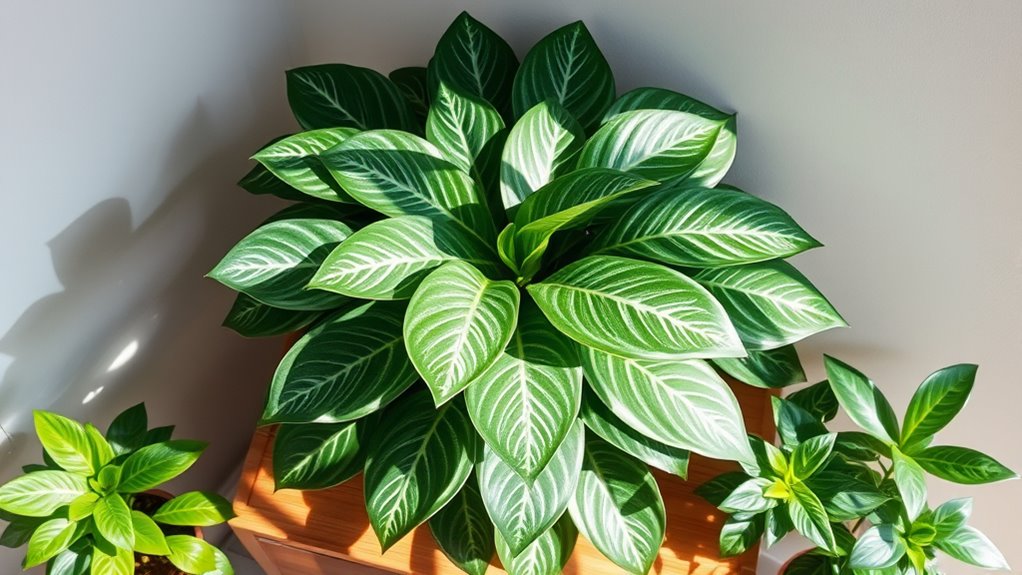
Ever wondered why the Chinese Evergreen (Aglaonema commutatum) is a popular choice for indoor gardening? Its attractive, glossy leaves with vibrant variegations add a splash of color to any space.
This indoor plant thrives in bright, indirect light but can handle low-light conditions, making it perfect for various rooms. It prefers well-drained, slightly moist soil and should be watered when the top inch feels dry.
Not only is it low maintenance, but it also helps improve air quality, making it an air-purifying houseplant. Keep in mind, it’s toxic to pets, so place it out of their reach.
Its ease of care and decorative appeal make it ideal for beginners seeking a versatile, stylish, indoor plant.
- Attractive, colorful foliage for interior decor
- Tolerates low light, perfect for various spaces
- Enhances air quality with its air-purifying properties
Frequently Asked Questions
What Are the Best Plants to Grow Indoors for Beginners?
When you’re starting with indoor gardening, choose plants that are easy to care for. Opt for the Snake Plant, which needs minimal watering and tolerates low light.
Pothos is another great choice because it adapts to various conditions and propagates easily.
The ZZ Plant and Peace Lily also thrive with little attention, making them perfect for beginners.
These plants help you build confidence while beautifying your space effortlessly.
What Plant Removes 78% of Airborne Mold?
Imagine a tall, sleek plant standing silently in your room, its upright leaves like green blades catching airborne mold particles. That’s the Snake Plant, also known as Sansevieria trifasciata.
It actively filters the air, removing up to 78% of airborne mold, thanks to its unique structure.
Easy to care for and thriving in low light, it’s perfect for improving your indoor air quality with minimal effort.
What’s the Easiest House Plants to Take Care Of?
When you’re looking for the easiest houseplants to care for, you want options that tolerate neglect and low light. Snake Plants and ZZ Plants are nearly indestructible, needing infrequent watering and thriving in dim spaces.
Pothos are adaptable and forgiving, while Peace Lilies and Cast Iron Plants handle low light and irregular watering well.
These plants are perfect for beginners who want low-maintenance greenery without much fuss.
What Is the Best Plant to Grow for Beginners?
You’re wondering what the best plant for beginners is. The Snake Plant is an excellent choice because it thrives on neglect, tolerates low light, and doesn’t need frequent watering.
It’s resilient and low-maintenance, making it perfect if you’re just starting out. Plus, it adds a sleek, modern look to your space.
With a Snake Plant, you can enjoy the benefits of indoor gardening without the stress of constant care.
Conclusion
Choosing the right indoor plants can transform your space and boost your mood. Did you know that studies show houseplants can reduce stress and increase productivity by up to 15%? With options like snake plants and pothos, even beginners can enjoy a lush, healthy indoor garden. Start small, stay consistent, and watch your green space thrive. Your new leafy friends will bring life and freshness to your home—and it’s easier than you think!
